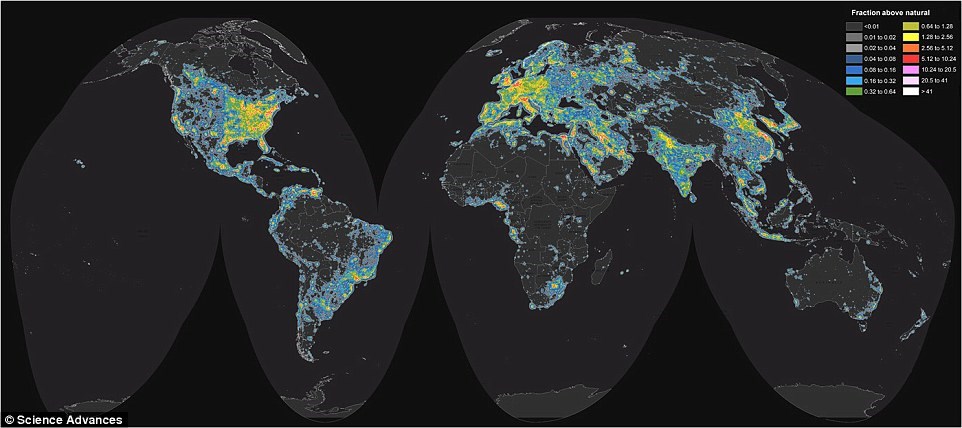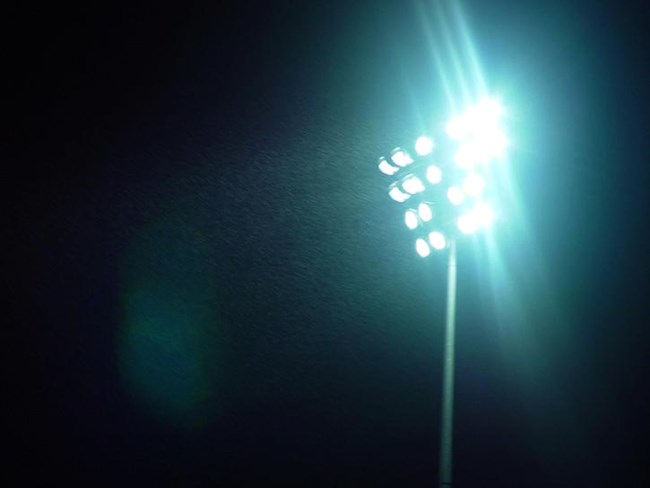
Falchi F, Cinzano P, Duriscoe D, Kyba CC, Elvidge CD, Baugh K, Portnov BA, Rybnikova NA, Furgoni R. New world atlas of artificial night sky brightness. Sci Adv. 2016 Jun 10;2(6): e1600377. doi: 10.1126/sciadv.1600377. PMID:27386582; PMCID: PMC492
What is light pollution
Light Pollution is the excess or inappropriate artificial light outdoors. Light pollution occurs in three ways: glare, light trespass, and skyglow.
-
Glare is the bright and uncomfortable light shining directly to the observer that interferes with your vision.
-
Light trespass is the unintended spill of artificial light into other people’s property or space and often becomes a source of conflict.
-
Skyglow is the brightening of the night sky from human-caused light scattered in the atmosphere.
Outdoor lighting is often necessary for a productive modern society, nonetheless the widespread use of artificial light has substantially altered the natural pattern of darkness and obscured our view of the natural night sky. The brightening of the night sky is not limited to urban environments as the glow from cities has been documented by the NPS at distances over 200 miles from national parks.

NPS/Ben Banet
Growth of light pollution
Light pollution is increasing globally, in both developed and developing countries. Satellite data show that from 2012 to 2016, continuously lit areas brightened at a rate of 2.2% per year [1]. The naturally dark area is shrinking too as Earth’s artificially lit outdoor area grew by 2.2% per year [1]. Furthermore, recent citizen scientists’ measurements indicate that the average night sky got brighter by 9.6% per year from 2011 to 2022, which is equivalent to doubling the sky brightness every 8 years [2].
The exceptions to this rapid light pollution growth rate include areas where lighting regulations have been created and enforced, such as Tucson, Arizona, portions of Northern Italy [3], and Flagstaff, Arizona [4].
Adverse effects of light pollution
Light scattered through the atmosphere brightens the night sky, making stars and planets impossible to see due to the reduced contrast. Light pollution also prevents the human eye from fully dark-adapting and reaching its maximum sensitivity. Sometimes, the more light there is at night, the less we can see. Light pollution tends to be most acute in urban environments, have pronounced ecological effects, and potentially influence human circadian rhythms. Light pollution also disrupts ecosystems, wastes energy, increases impacts of climate change and can have adverse health effects in humans.
In a remote or otherwise dark environment, visual impacts from light pollution are perceived at longer distances. Even if the area of the sky near the Zenith is relatively free of scattered anthropogenic light, areas near the horizon may appear bright or individual light domes from distant cities may be seen. In a natural protected area like a national park, these bright areas produce a measurable impact on a park’s the natural condition.

Impacts on Human Health, Public Safety, and Visitor Experience
The nighttime environment plays an integral role in human health and physiology. Dark nights (and bright days) are key in keeping our circadian rhythm in sync. It is well documented that without the restorative power of consistent restful sleep, serious health consequences can arise.
Artificial light can impact visitors in two ways: direct glare from light fixtures can affect vision and nighttime recreation experiences; and sky glow from collective sources of artificial light scattered in the atmosphere can obscure views of the night sky. Both aspects of artificial light can unnaturally illuminate the ground and diminish visitors’ ability to dark adapt their vision, cause blind spots, and create potential safety issues as well. (e.g., wildlife/visitor conflict).
Air pollution and clouds make light pollution brighter
Air pollution and other atmospheric conditions further scatter artificial light making the night sky even brighter and harder to see. The atmosphere includes molecules of gases, such as nitrogen, oxygen, water vapor, and carbon dioxide. The atmosphere also includes aerosols, such as dust, soot, salts, and chemical precipitates. The amount and type of aerosols, moisture level in the air, and the altitude above sea level are the primary variables determining the scattering that will occur. Increasing the aerosol content in the atmosphere will increase scattering, making light domes appear larger and brighter to nearby observers. Therefore, aerosols from the haze, dust, and air pollutants tend to enhance the skyglow.
In addition, clouds over the cities will make the night skies brighter. Clouds reflect the light back downward and increase scattering. The combination of these effects redirects the upward escaping light back to observers. Clouds over a city light dome can enhance the sky brightness by as much as 1000 times compared to a clear night.
Left image
Light pollution on mostly clear night, Lake Chelan, WA
Credit: Li-Wei Hung
Right image
Light pollution magnified on cloudy night over Lake Chelan, WA
Credit: Li-Wei Hung
Estimating skyglow impact from cities
Models and measurements of the brightness of city light domes show a relationship between the city's population and the distance to the observer. This relationship is known as Walker's Law. Primarily derived from actual observations, this formula may predict the anthropogenic skyglow:
Skyglow = C x Population x (Distance)-2.5
The constant C is dependent on the units of luminance used and the per capita "escaped light" of the city. Cities at closer distance with larger populations are predicted to cause greater light pollution.
References:
[1] Kyba, Christopher & Kuester, Theres & Sanchez de Miguel, Alejandro & Baugh, Kimberly & Jechow, Andreas & Hölker, Franz & Bennie, Jonathan & Elvidge, Christopher & Gaston, Kevin & Guanter, Luis. (2017). Artificially lit surface of Earth at night increasing in radiance and extent. Science Advances. 3. e1701528. 10.1126/sciadv.1701528.
[2] Kyba, Christopher & Altıntaş, Yiğit & Walker, Constance & Newhouse, Mark. (2023). Citizen scientists report global rapid reductions in the visibility of stars from 2011 to 2022. Science (New York, N.Y.). 379. 265-268. 10.1126/science.abq7781.
[3] Falchi F. 2011. Campaign of Sky Brightness and Extinction Measurements Using a Portable CCD Camera. Monthly Notices of the Royal Astronomical Society, Vol 412:1.
[4] NPS measurements from 2002-2012 Night Sky Data Collection Sites - Night Skies (U.S. National Park Service) (nps.gov)
Scientific Research
To learn more about the effects of artificial light on wildlife and humans, see NSNSD’s Annual Synthesis of Studies on the Effects of Light : a systematic, comprehensive up-to-date query of the scientific literature. To date, more than 600 peer-reviewed studies on the effects of artificial light at night (ALAN) have been published. The synthesis summarizes the science and highlights suggested readings from the most current publications.
Last updated: March 31, 2025
